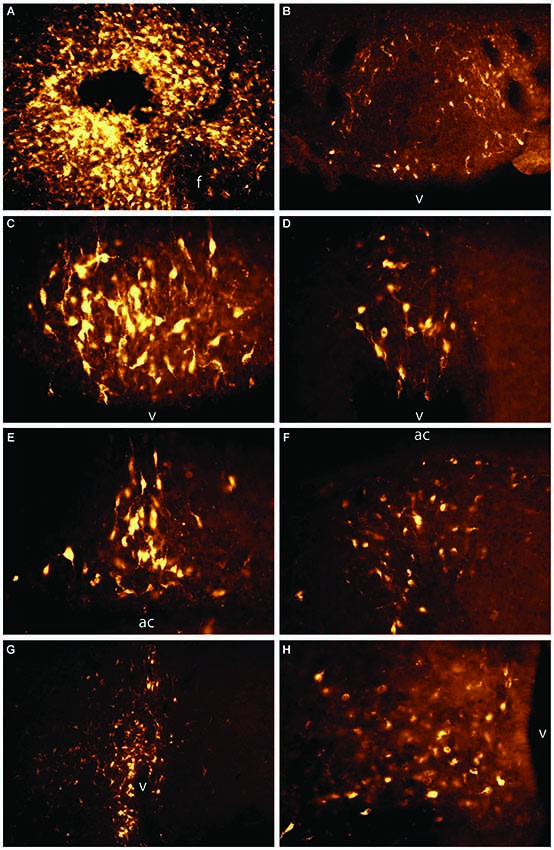

Experiments performed in behaving cats demonstrate that low-volume microinjections of hypocretin-1 in the vRPO produce a significant suppression of REM sleep (Moreno-Balandrán et al., 2008). On the other hand, microinjections of hypocretin-1 or hypocretin-2 in different brainstem structures of rat and cat produced different effects in the sleep–wake cycle (SWC), depending on the brainstem structure injected (Xi et al., 2001, 2002 Xi and Chase, 2006). These observations have been corroborated in rats by the presence of Orx immunoreactive fibers and terminals described throughout the whole central nervous system, except for the cerebellum, but including limbic and arousal-mediating regions (Peyron et al., 1998 Nambu et al., 1999 Baldo et al., 2003 Ciriello et al., 2003 Stoyanova and Lazarov, 2005) as well as in the cat's hypothalamus and brainstem (Zhang et al., 2001, 2004). Neural tracing studies performed mainly in rodents but also in cats have shown that the hypothalamic Orx neurons extensively project to numerous forebrain, brainstem, and spinal cord structures (Peyron et al., 1998 Zhang et al., 2004 Lee et al., 2005 Núñez et al., 2006 Badami et al., 2010). The orexinergic (Orx) neurons described in the lateral and posterior hypothalamus of several species, including humans, play a key role in the integration and stabilization of arousal networks as well as in the physiopathology of narcolepsy/cataplexy (Sakurai et al., 1998 de Lecea et al., 1998, 2002 Chemelli et al., 1999 Lin et al., 1999 Nambu et al., 1999 Nishino et al., 2000 Peyron et al., 2000 Thannickal et al., 2000 Hara et al., 2001 Zhang et al., 2002 de Lecea and Sutcliffe, 2005). As this nucleus maintains reciprocal connections with structures involved in the control of wakefulness (W) and non-REM (NREM) sleep, the shift from one sleep state to another depends on the balance between excitation and inhibition, resulting from the different biochemical natures and effects of the different neurotransmitters implicated in these connections, which are also under circadian and homeostatic control (Reinoso-Suárez et al., 2001, 1994 Rodrigo-Angulo et al., 2000, 2005, 2008 de la Roza and Reinoso-Suárez, 2001, 2006 de la Roza et al., 2004 Núñez et al., 2009). In the cat, the ventral part of the oral pontine reticular nucleus (vRPO) has been described as a nodal link in the neuronal network responsible for the generation and maintenance of rapid eye movement (REM) sleep (Reinoso-Suárez et al., 1994, 2001 Garzón et al., 1997, 1998). Our results suggest that the widely distributed Orx neuronal hypothalamic groups could physiologically inhibit REM sleep generation in vRPO. A considerable number of double-labeled neurons were also observed in both the dorsal and the lateral hypothalamic areas in the contralateral hypothalamus. A large number of double-labeled neurons (Orx–CTb) intermingled with the single CTb-positive and single Orx neurons were detected in the ipsilateral lateral, perifornical, dorsal, anterior, perimammillothalamic, and posterior hypothalamic areas but were very scarce in the paraventricular, dorsomedial, ventromedial, and periventricular hypothalamic nuclei. Brains were processed employing both CTb staining and antiorexin-A immunocytochemistry techniques. Five adult cats received microinjections of the retrograde tracer cholera toxin (CTb) into the vRPO. The aim of this study is to map the hypothalamic Orx neurons that project to the vRPO and suppress REM sleep generation in the cat. In the previous investigations, low-volume and dose microinjections of hypocretin-1 in cat vRPO produced a specific and significant suppression of REM sleep. Hypothalamic neurons containing the peptide hypocretin-1 (also called orexin-A) which will be herewith defined as orexinergic (Orx) neurons, occupy a pre-eminent place in the integration and stabilization of arousal networks as well as in the physiopathology of narcolepsy/cataplexy. The cat ventral oral pontine reticular nucleus (vRPO) is responsible for the generation and maintenance of rapid eye movement (REM) sleep.


 0 kommentar(er)
0 kommentar(er)
